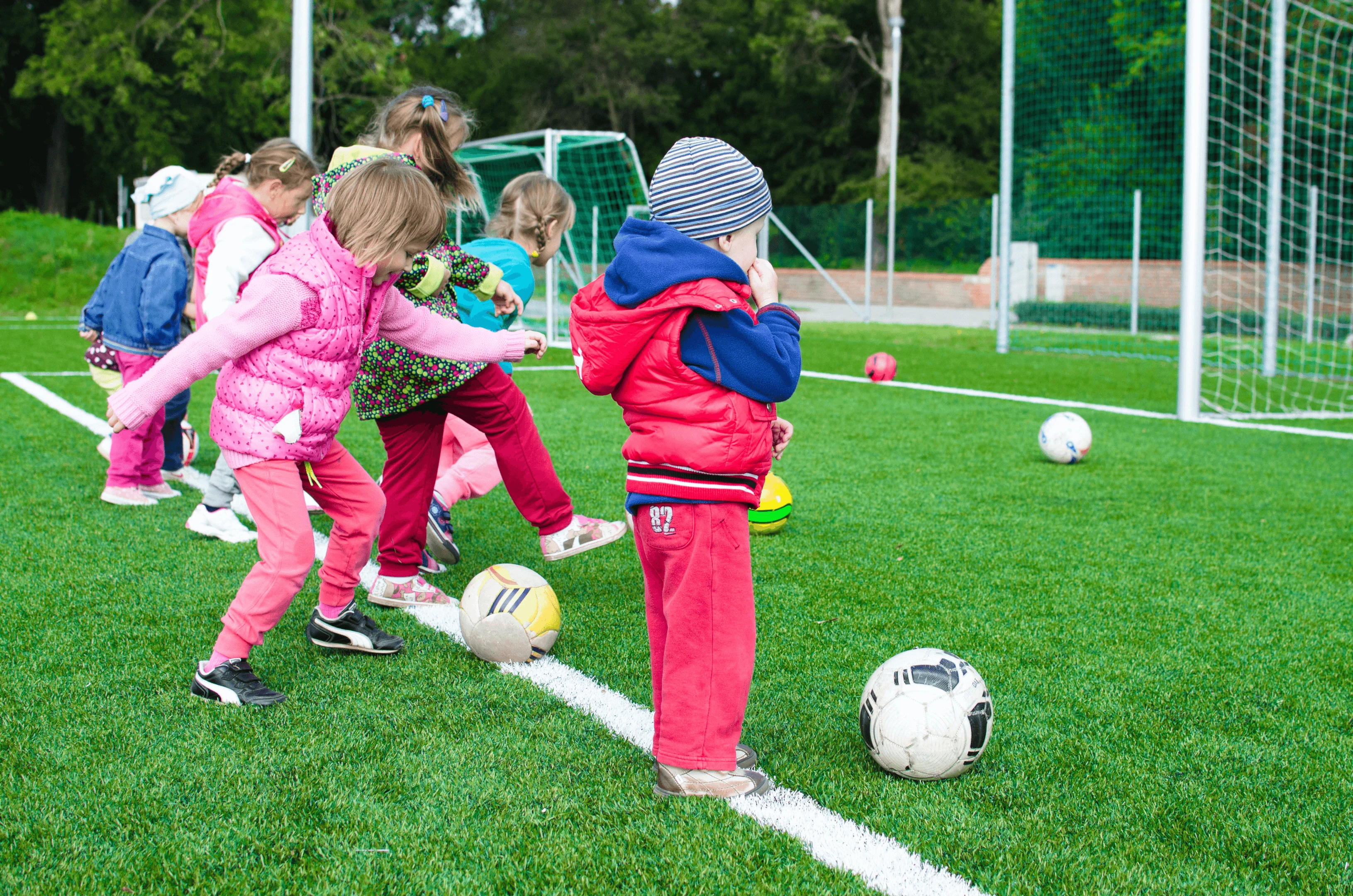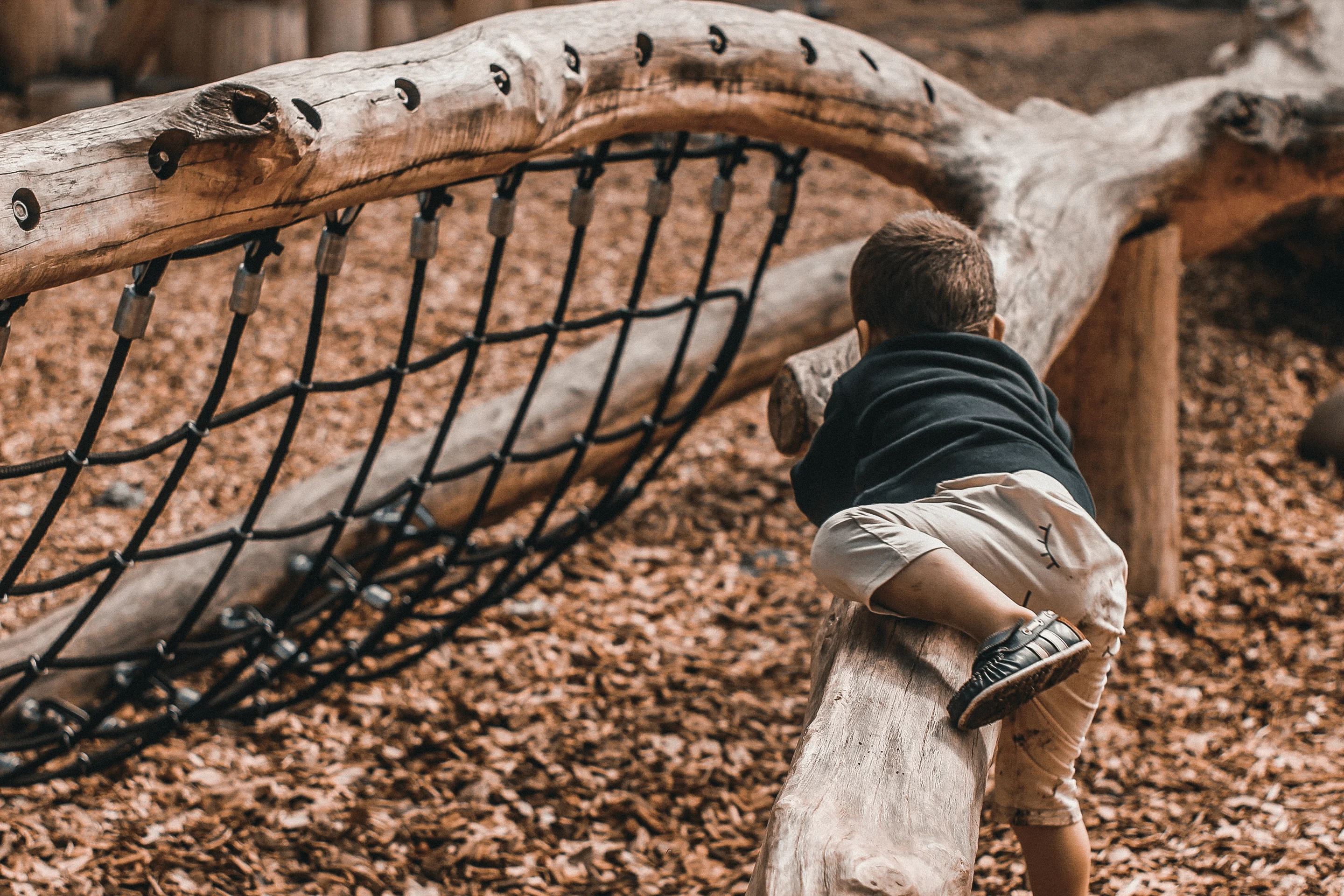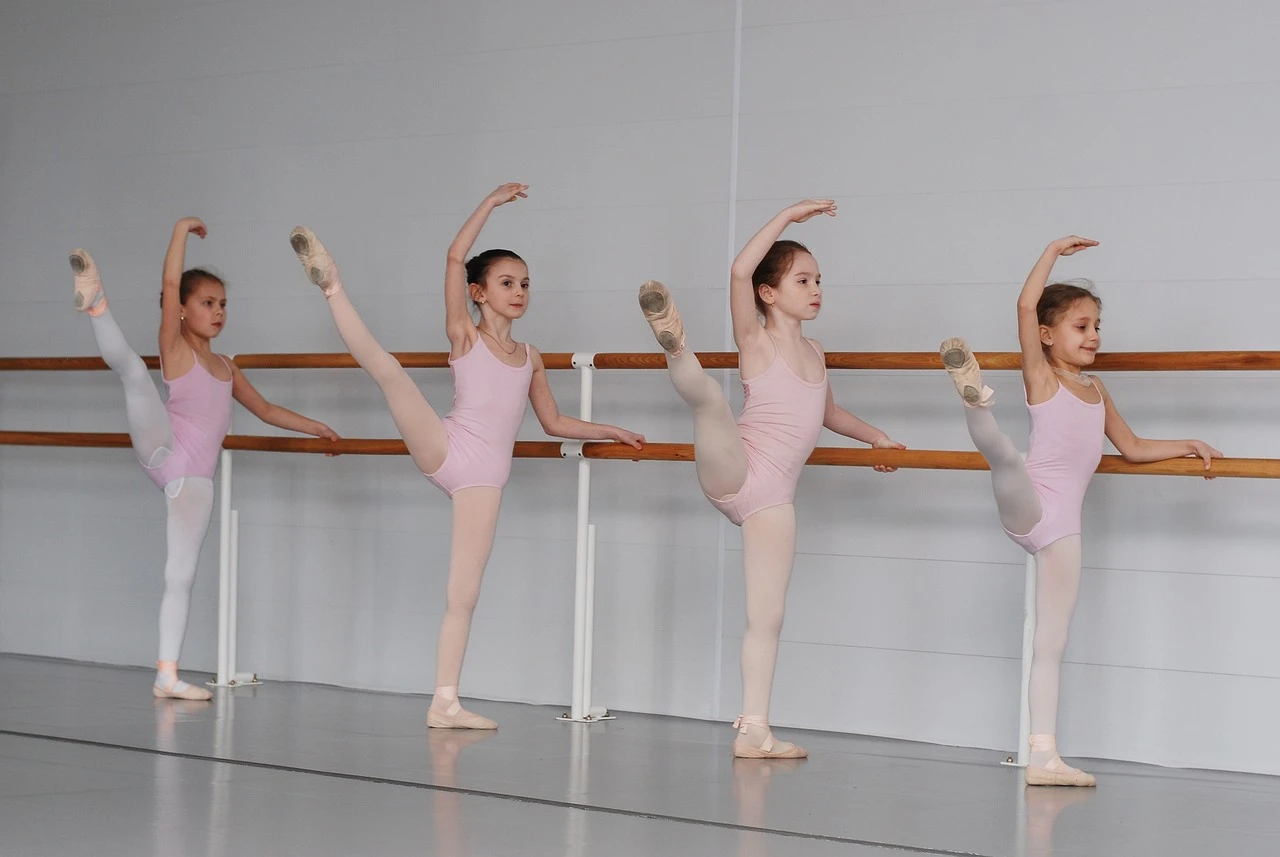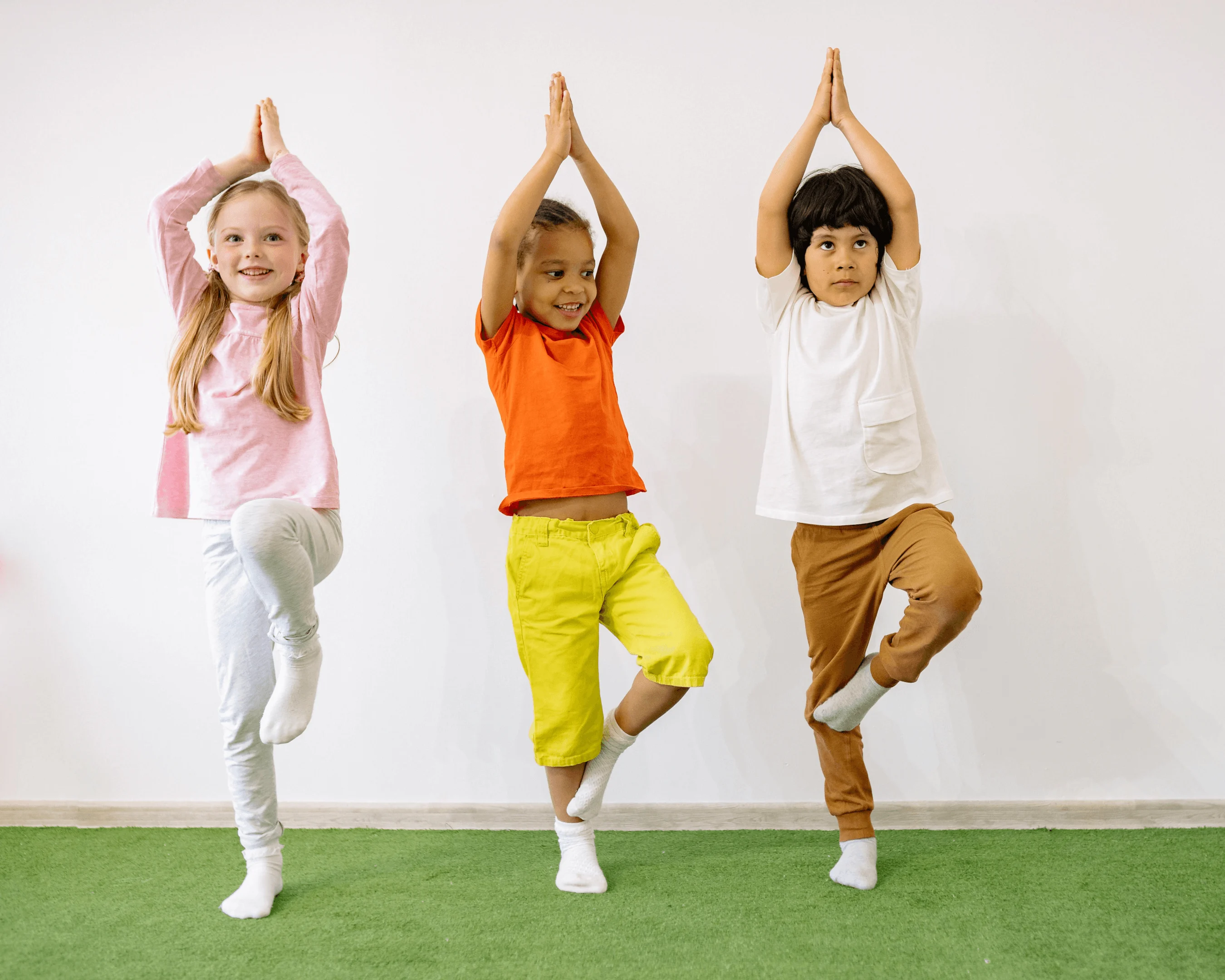What are Gross Motor Skills?

Gross motor skills are the large movements that young children develop as they learn to move—movements like crawling, standing, running, jumping balancing and climbing.
Fine motor skills, on the other hand, refer to the smaller movements that children learn to do as they develop their physical skills, such as pinching, gripping, twisting and squeezing.
Don’t Children Develop Those Skills Naturally?
Typically, developing children seem to have an inborn desire to develop physical skills that help them become less dependent on their parents. You may notice your baby or toddler insisting on feeding themselves (even if it does get messy).
Generally, three-year-olds start to want to dress themselves and use their developing fine motor skills to zip up, and do up buttons, or they try to pour their own drink as their coordination skills slowly improve. They need plenty of opportunities to practice both smaller and larger movements (or gross and fine motor skills) so that they can grow in physical confidence.
Try not to be too overprotective, as children need lots of opportunities to practice gross motor movement. Sometimes this means they will tumble and fall, but this is all part of the learning process. The more opportunities for large motor skills you allow, the more independent and confident they will be when they go to preschool. So wherever you can, allow them to balance, climb and roll, and stand nearby just in case they need you.
How Can I Help My Preschooler Develop Gross Motor Skills?
Simple! Follow these gross motor skills activities below, making sure you keep it playful and have lots of fun. If your child isn’t ready to do any of the activities, it’s not a problem. Step back and revisit them at a later time. All children develop at different rates.
1. Spinning
As preschoolers begin to learn all about the world around them, one of the things they often show an interest in is spinning. You may notice your child spinning the wheels of a toy car repeatedly, experimenting with turning a tap on and off, or spinning the toilet roll from the holder. You might also notice them spinning their own body, spinning round and round until they make themselves dizzy. This is all part of a typically developing child’s journey, and we can use this interest to help their gross motor skills develop, too.
Spinning involves quite a bit of balance and coordination so you may need to support your child at first. Encourage holding hands and making circles to play games and sing songs like:
The farmers in his den.
The farmers in his den,
Ey aye adio
The farmers in his den.
As you sing the rhyme, one child stands in the center as the farmer and all the other children hold hands and walk around in a circle.
The farmer wants a wife,
The farmer wants a wife,
Ey aye adio
The farmers wants a wife.
Another child joins the “farmer” in the center and spins around holding hands with the farmer.
Now sing the next verses, adding one more child into the center at each new verse so that you have a small spinning circle in the center, surrounded by a larger spinning circle.
The wife wants a child…
The child wants a dog…
The dog wants a bone…
We all pat the bone… (the larger circle all move in towards the smaller circle and gently pat the child that is the bone).
All preschoolers love to do the Okey-Cokey. Follow this link for a super simple version if you’ve never played it before. It will keep your preschoolers focused and spinning around in no time.
As you hold hands in a circle, ask everyone to stretch their arms wide but not to pull on each other’s arms.
Slowly walk around in a clockwise direction as you sing.
Follow-up spinning activities: Provide a collection of different-sized balls to play with to discover how they move and spin.
Introduce floaty scarves and ribbon sticks. Put some music on and encourage your preschoolers to twirl around as they dance.
2. Rolling
Rolling is a really important gross motor skill that involves using all the core muscles. It is a skill that is often overlooked in preschool settings, but it is crucial to provide plenty of rolling opportunities.
Outdoors: You can adapt your environment quite easily to make opportunities to roll.
A simple mound of earth, grassed over, can provide countless physical opportunities to run up and roll down.
Indoors: Provide mats, pillows and cushions to roll across. Encourage the preschoolers to lie on the floor, reach their hands above their heads, and try to make their bodies as long as they can. Now twist themselves and try to roll across the mat in a straight line.
It’s not as easy as you think for little ones to stay in a straight line, so provide lots of practice.
Follow-up rolling activity: You can also try the happy baby yoga pose with pre-schoolers. Encourage them to lie on their backs and grab their feet with their hands. Hook your hands around your feet or hold onto your big toes. Now simply roll around on your back like a happy baby. You can even make baby noises if you want to!
3. Climbing

Many young children seem to have an innate desire to climb. Climbing is very physical and tiring. It involves the use of lots of essential muscles as well as good coordination and balance. It is a key gross motor skill, and we need to give children plenty of safe, risk-assessed opportunities to climb in the early years.
Indoors: Provide climbing frames where the children can explore movements like pulling themselves up and shifting their body weight. Smaller climbing frames with slides are brilliant for this.
Outdoors: Larger climbing frames with ladders are great, but trees are also a gift for developing climbing. Stand nearby and don’t let your child climb higher than you.
Also, consider using pulleys thrown over the higher branches of trees. Pulling on a rope to cause an effect helps develop the pulling and pushing up and down movements that are also needed to climb.
Follow-up activities: Practice pushing umbrellas up and down to open and close them.
High washing lines: Attach objects to strings to jump up and reach for.
4. Balancing
Balancing requires good core strength, so it can be difficult for preschoolers at first. Be patient and give lots of encouragement if they can’t do it independently at first.
Outdoors: The outdoor world is full of natural opportunities to balance, such as:
Jumping over puddles
Skidding in the snow
Walking in soft sand or mud
Crossing a style or uneven patch of ground
Walking along a low wall
Climbing up steep steps
These all require a lot of balance.
Indoors: Provide stepping stones. You can buy wobbly plastic stepping stones that are perfect to help children develop their balance. Just Google for children’s stepping stones and a wide variety of options will show up. But you can also make your own stepping stones from upturned washing-up bowls and buckets. If they ask you to, hold your preschoolers’ hands to steady them until their confidence and independence grow and they start to balance themselves.
Follow-up activity: place planks across two upturned washing-up bowls to practice “walking the plank” just like a pirate, or place large hoops on the floor and try to walk the perimeter of a hoop without falling off.
5. Arm Circles
There are seventy muscles in your shoulder and arm that preschoolers need to develop before they will be able to comfortably hold a pen or pencil. Lots of large rotational arm movements, backwards and forwards are the best way to start building up those muscles, reaching up and down, and stretching from side to side.
Painting and decorating are great activities to develop those gross motor skills.
Outdoors: Provide paintbrushes (the real kind, just like painters and decorators use) and jars or buckets of water. Encourage your preschoolers to paint the fence, walls, and floor by dipping their brush in the water and using the biggest arm movements they possibly can paint with.
Indoors: In a large space, give each preschooler two ribbon sticks and play lively music to dance to. Model how to make huge arm circles, first forwards and then backwards.
Follow-up activity: Use large jumbo chalks to draw the biggest circles you can outdoors or use
water pistols to squirt water in large circle shapes.
6. Crawling
Crawling on all fours and commando crawling by pulling yourself along on your arms while lying on your tummy are both important stages in gross motor development. Sometimes, well-intentioned parents can move their child on through the crawling stage far too soon, and important core muscle development and brain connections can be delayed, so there is never any harm in going back and revisiting the crawling stage in the early years as it is a vital pre-cursor to many other skills.
Outdoors: Provide different kinds of tunnels, such as plastic fold-out tunnels or tunnels made from hoops, nets, and blankets to crawl under. Use large tarpaulins, sheets, and curtains to make dens to crawl through. Secure them with ground pegs.
Indoors: Large cardboard carpet inner tubes can also make great tunnels for little people.
Follow-up activity: Try taping large sheets of paper to the underside of a table and letting preschoolers crawl underneath and draw upside-down pictures.
7. Dancing

Dancing is such a joyful thing to do with preschoolers, as they don’t have the inhibitions that adults do. The good news is that dancing helps to develop coordination, balance, and fitness levels. It also builds new brain connections linked to good memory. So what are you waiting for? If you join in, you will get all of those benefits too!
Provide:
Lightweight scarves and ribbons
Long strips of floaty materials
Ribbon sticks (Make your own by tying ribbon to the end of sticks.)
Scrunchies
Wrist bells
Percussion instruments
Crepe paper cut into long, thin strips
Balloons
Bubbles
Some lively music
8. Scooping
Scooping and digging are skills we take for granted, but they are super important in each child’s gross motor development. This is the beginning of weight bearing, as we use upper body strength to lift and use our power.
Outdoors: Provide digging areas for real-life experiences of digging over the earth with tools like spades, forks and trowels (You can buy child-sized tools or cut down adult tools). Use the digging area throughout the year, as warm, dry soil is a very different experience from heavy, wet soil. Encourage your preschoolers to scoop out the earth and dig holes with their tools. This will bring lots of opportunities to develop their knowledge and understanding of the world, as you can talk about what happens under the ground.
Indoors: Use large sand trays with spades, scoops and rakes of different sizes. Add water trays with buckets, water wheels, watering cans, jugs, and empty recycled bottles to scoop up and pour water.
Follow-up activity: Provide child-sized wheelbarrows and rakes to rake up and scoop up piles of autumn leaves.
9. Yoga Moves

Yoga has so many benefits that I could write a book about it! The good news is that there is no age limit (either way) for yoga. And some lovely yoga programs and books for early years children have been developed over the past few years.
You don’t need to be a trained expert to start introducing your preschoolers to some simple yoga moves. Yoga is great for developing flexibility, balance, coordination and strength. In fact, it’s amazing for developing all gross motor skills.
Try some of the following moves with your preschoolers. Support them in finding a good space and playing some relaxing music in the background. We’ve already tried a happy baby pose, so here are a few more:
Angry cat
On all fours, arch your back as high as you can, keeping your arms strong and planted firmly on the floor. Tuck your head under as far as you can.
Happy cat
Reverse your angry cat by pushing your tummy down towards the floor and holding your head high. Push your bottom into the air, but keep your hands and knees firmly on the ground.
Downward dog
Plant your hands and feet on the floor and push your hips towards the ceiling. Try and push your feet into the floor so your heels are down.
Three-legged dog
In a downward dog, lift one leg as high as you can first, then bring it down and lift the other leg.
If your preschoolers enjoyed those yoga moves and you would like more, follow this link.
10. Peddling
Peddling is all about developing both lower and upper body strength. It also takes balance and coordination, but once preschoolers grasp it, they seem to grow in confidence, so it’s a lovely skill to develop.
Indoors: Following your yoga moves, lie on your back and peddle your legs in the air.
Ask your preschoolers to draw circles in the air with their knees. You could do this as a warm-up before dancing or yoga. Stepping up and stepping down can also help to develop the muscles needed to peddle.
Outdoors: Provide a selection of wheeled toys like scooters, balance bikes, 3-wheeled tricycles, and 2-wheeled bikes. Stand nearby to provide support when necessary.
Why Do We Need to Work on Physical Development?
Physical development is incredibly important for preschoolers. In our Western cultures, we are rapidly moving away from giving our young children enough time for the physical opportunities they need to develop gross motor skills.
Gadgets like baby bouncers, high chairs, strollers, baby walkers, and car seats all have great advantages, but they can also mean that babies and young children spend their day moving from one gadget to another, with little time left for free play on the floor or rough and tumble play with a parent.
Free play time is when children naturally develop their core muscles by exploring, crawling, pulling themselves up, rolling, and climbing, but a growing number of children are missing out on these important stages.
If you would like further ideas to develop your child’s gross motor skills, you can find more fun gross motor activities by following this link.
Have fun.
